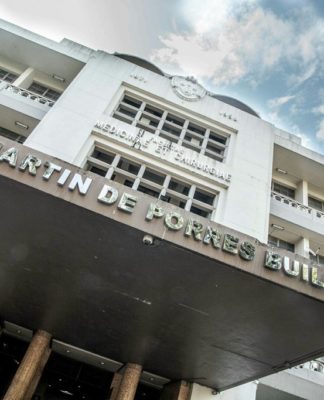THE JOURNALIST who was allegedly killed for his fight against illegal mining in Palawan was named a “UST Modern Day Martyr” by the Faculty of Theology in the annual UST Martyrs’ week last Sept. 24 to 26.
Gerardo Valeriano Ortega, also known as “Doc Gerry” or “Ka Gerry,” died last Jan. 24 after a gunman shot him at the back of his head. This was around 10:30 a.m. when he finished broadcasting in his morning show “Ramatak” for DWAR Radyo Mo Nationwide’s Palawan station. He was preparing for a flight to Manila to promote the “Ten Million Signatures” campaign against mining.
Gerry had great love for his countrymen especially for the Palaweños, said Michaella Ortega, his oldest daughter, in a talk on “real martyrdom” at the UST Martyrs’ Hall last Sept. 26.
“Doc Gerry always told himself during the EDSA Revolution that ‘This is how I’m going to die. I will die with a noble death.’ That means he wanted to die selflessly—that he wanted to die for his country,” Michaella said in the forum with a theme “The Blood of Martyrs: the seed of Christianity.”
Michaella expressed her desire to make her father’s death meaningful.
“Our task, being the audience, spectators, and being the people that these people died for is to keep fighting, to not let their death be meaningless,” Michaella said. “I don’t think he set out to be a martyr. He loved life, but he had to fight because it’s the right thing to do.”
Gerry was a broadcaster, veterinarian, politician, environmental activist, and community organizer. He was known for his promotion of crocodile farming in the Philippines. Some of his projects were ecotourism sites in Palawan that offered “Firefly Watching” and “Ugong Rock Climbing” in Palawan.
As the project director of Bantay Kalikasan-Palawan, Gerry led the establishment of five community-based sustainable tourism sites. He resigned from his post at Crocodile Farm to run for a position in the Provincial Board of Palawan during the 2001 elections. He won and held the post until 2004.
In 2004, Gerry was said to have gained access to information and documents about widespread corruption in the provincial government of Palawan. In January 2011, Bantay Kalikasan launched a broad campaign against mining in Palawan, after the supposed approval of large-scale mining by the Palawan Council for Sustainable Development.
Thomasian martyrs
Fr. Louie Coronel, O.P., a theology professor, said the Martyr’s Week celebration aims to promote the devotion of the Catholics to the UST martyrs and to provide opportunities to appreciate more the universal call to holiness and sanctification.
“This celebration is a history telling because the martyrs are the seeds of the Church,” said Faculty of Sacred Theology Dean Fr. Rodel Aligan, O.P. “The martyrs are the University’s source of unending grace, their experiences are the seeds of their commitment.”
The Carillon Bells in front of the UST Central Seminary chapel represent the martyrs.
“The Carillon bell serves as the martyrs’ monument which signifies the resounding victory of martyrs as witnesses to Christ,” Coronel said.
In an interview with the Varsitarian, Fr. Fidel Villarroel, O.P., archivist of the University, said there are three groups of Thomasian martyrs: martyrs of Japan, martyrs of Vietnam, and martyrs of Spain.
Among them are St. Antonio Gonzales, O.P., a former rector of UST, and Blessed Buenaventura Garcia Paredes, O.P., a former master of the Order of Preachers (O.P.).
The other martyrs of Japan are Domingo De Erquicia, O.P., Lucas del Espiritu Santo, O.P., Tomas Hioji de Jacinto, O.P., and Guillaume Courtet, O.P.
Thomasian martyrs of Vietnam include Vicente Liem de la Paz, O.P., Pedro Almato, O.P., and Bishops Domingo Henares, O.P. and Jose Ma. Diaz Sanjurjo, O.P.
The four other martyrs from Spain are Jesus Villaverde, O.P., Manuel Moreno, O.P., Pedro Ibañez Alonso, O.P., and Jose Ma. Lopez Carillo, O.P.
In their book, “The UST Martyrs of the Religious Persecution in Spain (1933-1937),” Fr. Noel Abalajon of the Archdiocese of Capiz and Fr. Pedro Tejero, O.P., Central Seminary spiritual director, stated two other names: Blessed Maximo Fernandez Marinas and St. Melchor Garcia Sampedro.
However, Villaroel said Blessed Marinas and Sampedro were not Thomasians because they both studied and taught in Spain, and not in UST.
There are no Filipinos on the list of Thomasian martyrs because priesthood was not open to indios (natives) during the 18th and 19th centuries. Lorenzo Ruiz, the first Filipino saint, was a lay companion of Gonzales, et al., and was killed with them in Japan.















